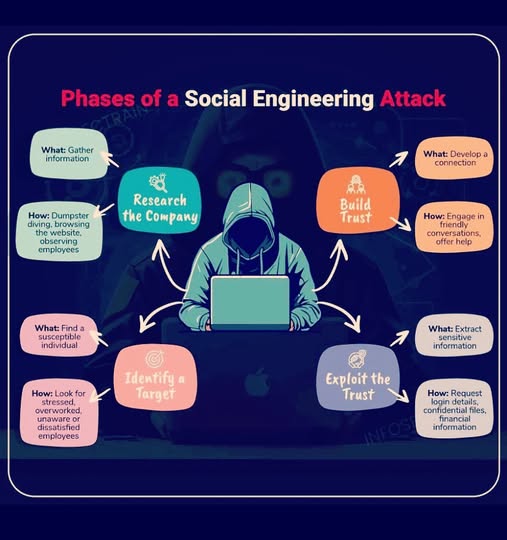
Social Engineering
🎭 Social Engineering: The Human Hack You Need to Know About
In cybersecurity, some of the biggest threats don’t come from viruses or hackers typing code in a dark room. Instead, they come from people tricking other people into giving away sensitive information. This is called social engineering, and it’s one of the most common—and dangerous—ways criminals target small businesses.

👀 What Is Social Engineering?
Social engineering is the act of manipulating someone into giving up confidential information or access. It doesn’t rely on hacking your systems—it relies on hacking your trust.
These scams are designed to feel urgent, convincing, and personal. They may look like emails from your boss, text messages from IT, or phone calls from a “bank representative.” In reality, they’re fraudsters trying to get you to click a malicious link, open an infected file, or give up a password.
🚩 How to Spot Social Engineering Attacks
Here are some warning signs:
Urgency: “Your account will be locked in 1 hour unless you act now!”
Impersonation: Emails pretending to be from Microsoft, the CEO, or your IT provider.
Emotional manipulation: “A wire transfer is needed immediately to save the deal.”
Requests for sensitive info: Passwords, bank details, or login credentials.
🛡️️ How to Protect Yourself and Your Team
1. Slow down and verify
If something feels off, pause and double-check. At Verenity, we take this seriously—when one of our technicians calls you, we use client-specific code words to prove it’s really us. These can be simple, like a favorite vacation spot or sports team, and we update them monthly or quarterly for each client. If you ever doubt a request, don’t hesitate to call us directly using the number you already have on file.
2. Don’t click links from unknown senders
Always hover over a link before clicking to see where it leads. Be especially cautious of attachments or unexpected requests.
3. Train your employees
Social engineering thrives on human error. Regular awareness training helps your staff recognize scams before they cause damage.
4. Use Multi-Factor Authentication (MFA)
MFA protects your accounts by requiring a second form of verification—even if a hacker has your password.
5. Keep software updated
Outdated software is an easy way in for attackers. Enable automatic updates and patch security flaws quickly.

🧠 🧠 Real-World Social Engineering Example: The “IT Support” Call
It’s 9:13 AM on a Tuesday. The front desk at a dental office receives a call:
“Hi, this is Michael from your corporate IT team. We detected a critical update failure on your front desk machine, and we need to resolve it ASAP before it causes issues with patient records.”
The caller sounds professional. He knows the office name, and he talks like someone in IT.
“Can you open your browser and go to support-fixit.com so I can remote in and handle it for you? It’ll only take 5 minutes.”
Feeling rushed—and not wanting to be the person who causes a delay—the front desk employee complies.
What just happened?
🎭 They were tricked. That wasn’t corporate IT. That was a social engineer impersonating support.
The fake site installed remote access software, giving the attacker full control of the workstation. From there, they accessed email, downloaded patient records, and installed malware—all in under 10 minutes.
🔐 How to Stop This
Verify the caller: At Verenity, we use client-specific code words to prove our identity.
Never follow instructions from unsolicited tech calls.
Always confirm directly with your known IT provider or manager before granting access.
💼 How Verenity Helps
At Verenity, we help small businesses like yours avoid social engineering traps through:
Security awareness training
Real-time threat detection
Multi-layered protection (email filtering, MFA, backups)
Ongoing monitoring and response
We make security simple and approachable—so you can focus on your business.
📅 Want to see how prepared your team is?
Schedule a free consultation or visit verenity.net
